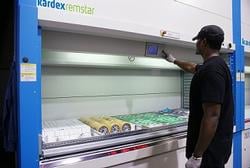
Seize manufacturing “reshoring” opportunities with ASRS Efficiencies
The underlying factors for moving manufacturing back to the United States from overseas may finally be trending in favor of U.S. sites. This shift – known as reshoring – is being driven by multiple factors, including rising labor costs overseas. But the shift away from offshoring is far from a foregone conclusion, nor is it a decision that is determined solely by labor costs. Automated storage and retrieval systems, such as horizontal carousels, vertical carousels and vertical lift modules, align process improvement strategies such as lean to close the manufacturing cost gap that sent companies to offshore in the first place. These technologies yield efficiencies through increased labor productivity, regained floor space and capacity and improved accuracy and quality, arguing the case for returning manufacturing to US soil.
While features among these product families vary, they all follow the “goods to person” principle in which the dynamic storage quickly and accurately moves goods to an operator. By contrast, a more traditional “person to goods” operation would have a worker walking through aisles of storage racks or shelves to locate goods, perhaps pushing a cart to move parts or bins, and using a pick list and/or scanner to verify the parts being picked. This way of doing things causes waste in the form of travel/motion, search time and time spent verifying a pick.
Dynamic storage does away with these inefficient processes by automatically bringing goods to the operator. ASRS inventory management software integrates with host systems to accurately fulfill customer orders and replenish the optimal inventory level in the ASRS. Dynamic storage can achieve space savings because of its efficient, dense use of vertical space as well as its ability to eliminate aisle space. Carousels, for instance, use a dense arrangement of various-sized totes and dividers to efficiently hold the needed mix of inventory. Shuttle VLMs have trays that all for variable increment storage heights inside the machine, rather than using fixed tray heights that waste space.
At the operator station itself, dynamic storage may make use of an operator interface panel or an integrated pick to light display to ensure rapid, accurate picking. Additionally, ergonomic hoists and lifting devices can be integrated with an ASRS to speed up operations and eliminate the manual lifting of goods, an especially important consideration in manufacturing work-in-process where heavy parts need to be moved. In some assembly environments, ASRSs may even be paired with materials handling robots to bring a high degree of automation to a manufacturing step.
As a result, dynamic storage can add up to significant productivity gains. Generally moving from traditional shelving to ASRS can cut the required labor by two-thirds, allowing companies to reassign people to more value-added activities in production or quality assurance. Eliminating wasted motion also results in better throughput. While incremental improvements in accuracy through dynamic storage may not seem like game-changers for U.S. manufacturing, when better accuracy can be combined with sizable improvements in labor productivity and space savings, the case for dynamic storage as an enabler of lean efficiencies is clear cut. Reshoring appears to be gaining momentum, but with off-shore locations still having much lower labor costs, North American manufacturing will need to be as lean and efficient as possible to turn the tables on offshoring.
Visit www.kardexremstar.com to learn more.









